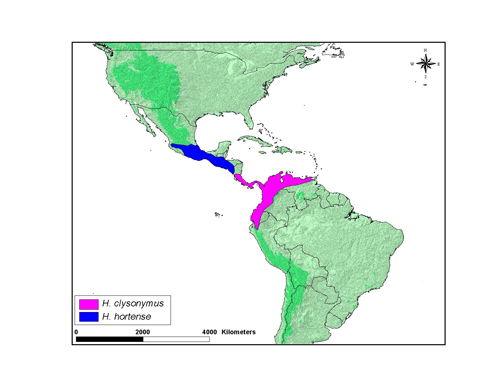Heliconius hortense
Margarita BeltránCharacteristics
Early stages: Eggs are yellow and females usually place eggs singly on growing shoots of the host plant. Mature larvae have a white body with black and orange spots, black scoli and yellow head; length is around 1.3 cm. Caterpillars are solitary (Brown, 1981).
Geographical Distribution
Heliconius hortense is distributed from Mexico to Nicaragua. This map shows an approximate representation of the geographic distribution of this species. The original data used to draw these maps are derived from Brown (1979) which is available at Keith S. Brown Jr. (1979). Ecological Geography and Evolution in Neotropical Forests
Habits
H. hortense occurs from sea level to 2,300 m in cloud forest. Usually individuals fly rapidly and in the lowerstory. The males sit on female pupae a day before emergence, and mating occurs the next morning, before the female has completely eclosed. Adults roost at night in small groups 2-10 m above ground in twigs or tendrils (Brown, 1981).
Host plant: H. hortense larvae feed primarily on plants from the genus Passiflora, subgenus Plectostemma (Brown, 1981).
References
Brown K. S. 1981 The Biology of Heliconius and Related Genera. Annual Review of Entomology 26, 427-456.
Guérin-Méneville F E 1844. Dixième ordre.- Les lépidoptères, pp. 466-530. In: Icono-graphie du Règne Animal de G. Cuvier... Paris, J. B. Baillière
Title Illustrations

| Scientific Name | Heliconius hortense |
|---|---|
| Location | Selva Negra, Nicaragua |
| Specimen Condition | Live Specimen |
| Sex | Female |
| Source | Mountain Longwing |
| Source Collection | Neotropical Butterflies |
| Copyright | © 2003 Richard Lehman |
| Scientific Name | Heliconius hortense |
|---|---|
| Location | Selva Negra, Nicaragua |
| Specimen Condition | Live Specimen |
| Sex | Female |
| Source | Mountain Longwing |
| Source Collection | Neotropical Butterflies |
| Copyright | © 2003 Richard Lehman |
About This Page

University of Cambridge, Cambridge, UK
Correspondence regarding this page should be directed to Margarita Beltrán at
Page copyright © 2010
 Page: Tree of Life
Heliconius hortense .
Authored by
Margarita Beltrán.
The TEXT of this page is licensed under the
Creative Commons Attribution-NonCommercial-ShareAlike License - Version 3.0. Note that images and other media
featured on this page are each governed by their own license, and they may or may not be available
for reuse. Click on an image or a media link to access the media data window, which provides the
relevant licensing information. For the general terms and conditions of ToL material reuse and
redistribution, please see the Tree of Life Copyright
Policies.
Page: Tree of Life
Heliconius hortense .
Authored by
Margarita Beltrán.
The TEXT of this page is licensed under the
Creative Commons Attribution-NonCommercial-ShareAlike License - Version 3.0. Note that images and other media
featured on this page are each governed by their own license, and they may or may not be available
for reuse. Click on an image or a media link to access the media data window, which provides the
relevant licensing information. For the general terms and conditions of ToL material reuse and
redistribution, please see the Tree of Life Copyright
Policies.
- First online 18 February 2007
- Content changed 12 August 2008
Citing this page:
Beltrán, Margarita. 2008. Heliconius hortense . Version 12 August 2008 (under construction). http://tolweb.org/Heliconius_hortense/72233/2008.08.12 in The Tree of Life Web Project, http://tolweb.org/







 Go to quick links
Go to quick search
Go to navigation for this section of the ToL site
Go to detailed links for the ToL site
Go to quick links
Go to quick search
Go to navigation for this section of the ToL site
Go to detailed links for the ToL site